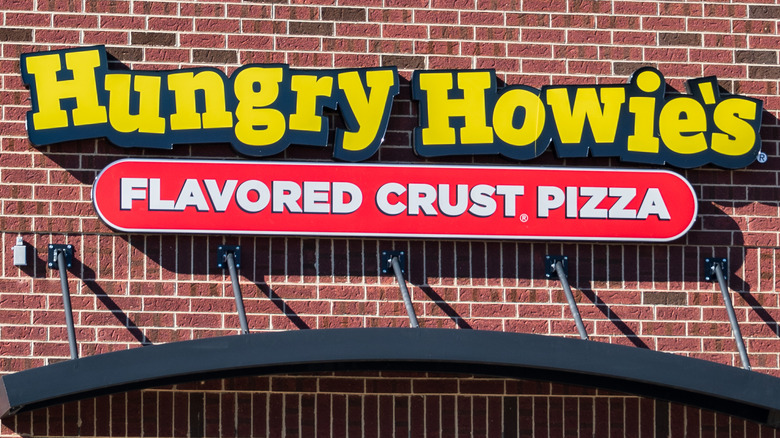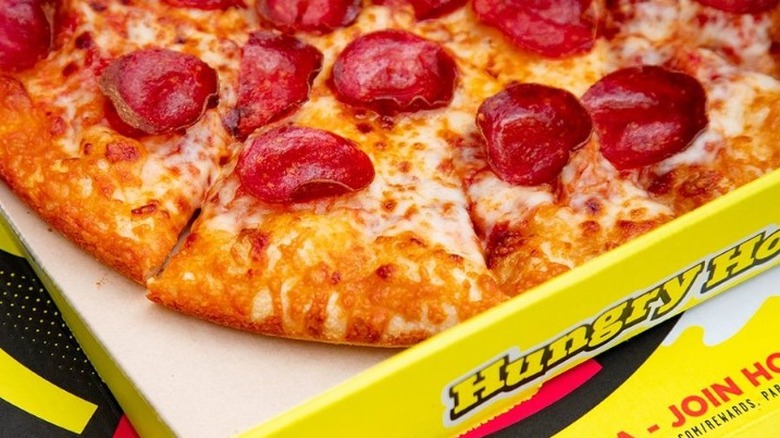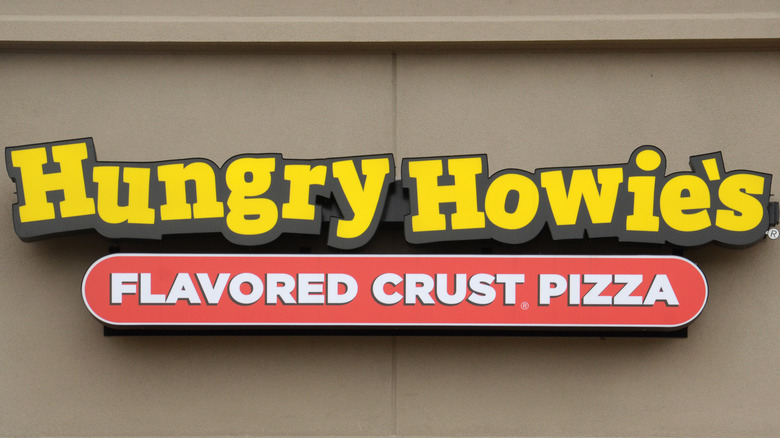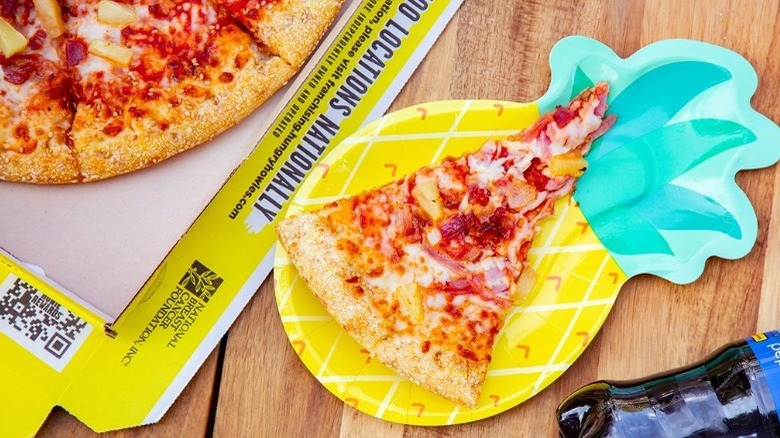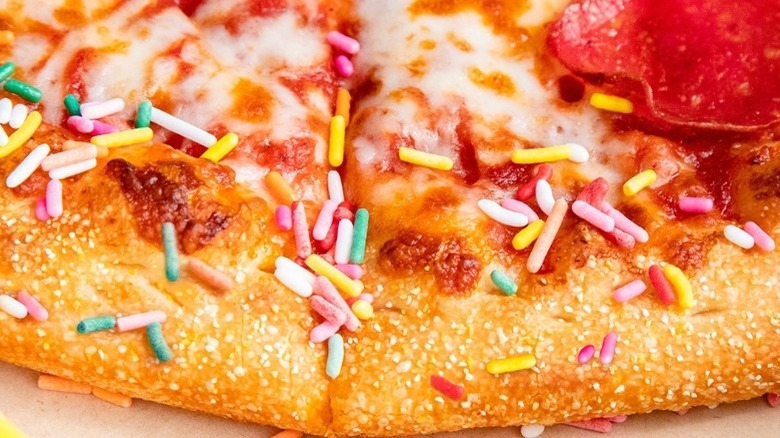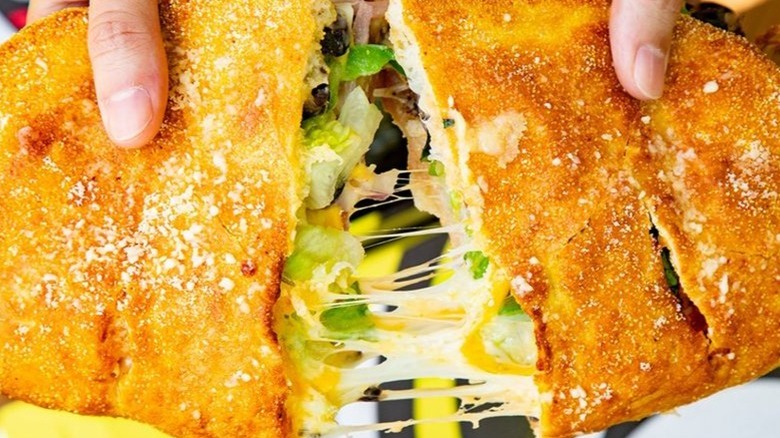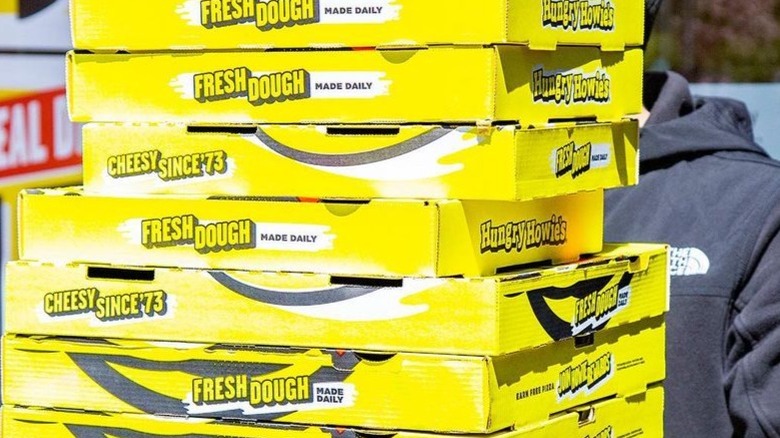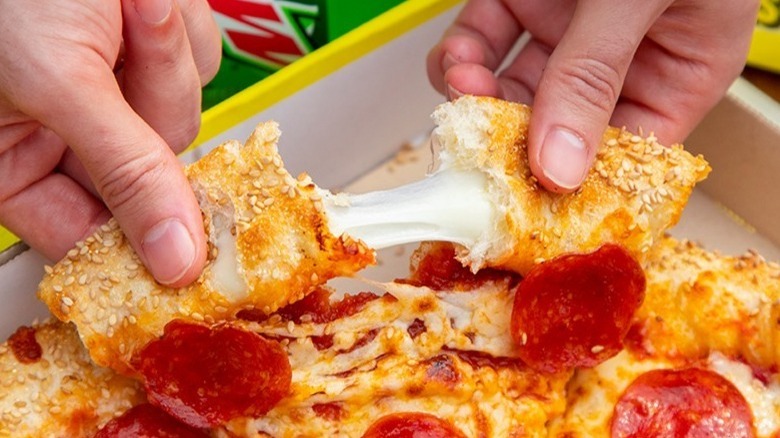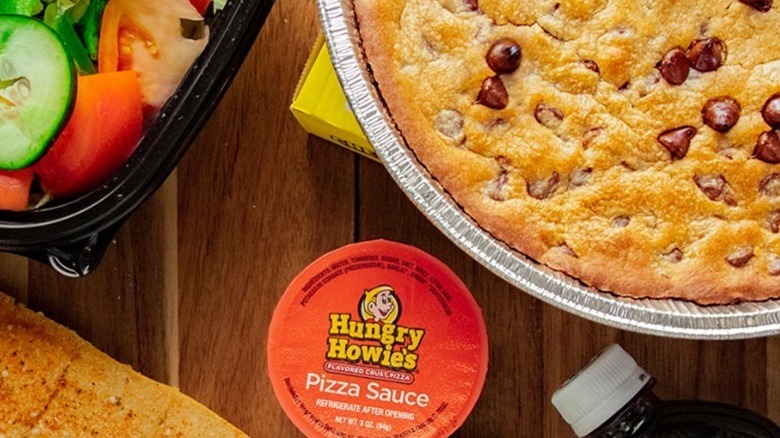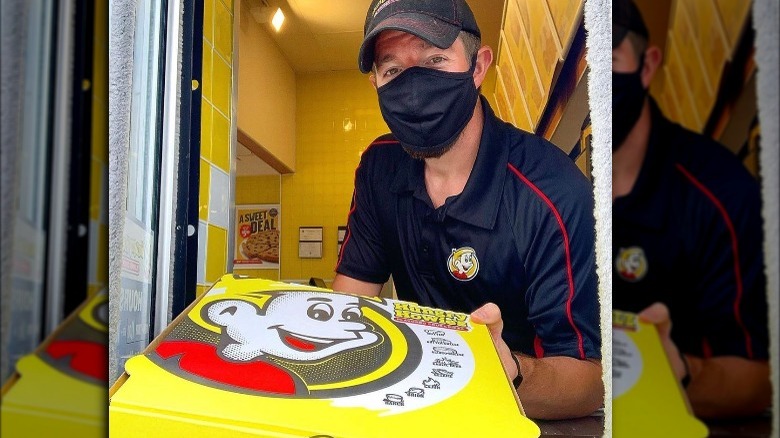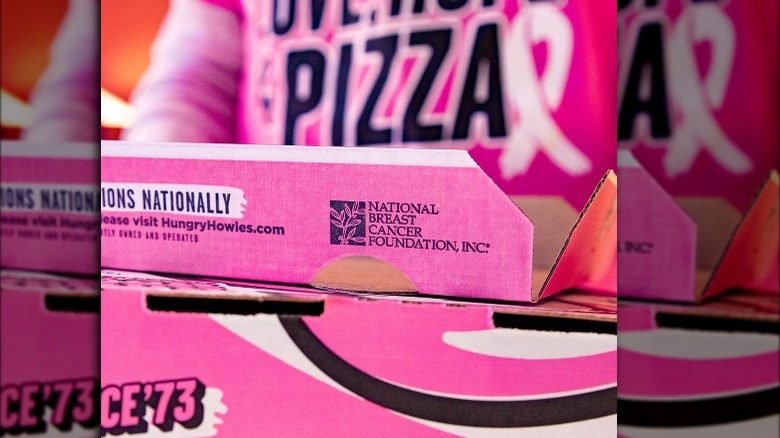Hungry Howie's CEO Tells Us Everything About The Pizza Chain - Exclusive Interview
Even if your pizza memory dates back that far, you might not have noticed that Hungry Howie's opened up around the same time and same place as the first Little Caesars and Domino's franchises. But Hungry Howie's was there, just a few years after those big chains kicked off. Back in the 70s, Steve Jackson, Hungry Howie's, CEO gave up a stable job on Ford's assembly line to work with Hungry Howie's founder Jim Hearn, and open the second-ever Hungry Howie's restaurant in Michigan (via Authority Magazine). It must have been hard for him, then, to imagine that 45 years later, he'd be at the head of a national chain in over 20 states, with over 500 locations.
The chain is only planning on getting bigger. "Just watch for us," Jackson told Mashed. "We think that when we come to your neighborhood, we'll be your pizza of choice. We look forward to being there." In an exclusive interview, Jackson made his case for the chain, giving us enticing insights into Hungry Howie's menu-development process, and hints at new dishes to come.
The under-appreciated pizza Steve Jackson wishes you would try
Steve, you've been with Hungry Howie's from almost the very beginning. You opened the second shop. What was the first Hungry Howie's pizza you've ever tried and what's your favorite to this day?
Well, as far as ordering the first pizza, I think 90% of the world loves just the basic cheese and pepperoni pizza and that's kind of the category that I fall into. I don't add many more toppings than that. Back in the '80s, we kind of expanded the opportunity with pizza by developing flavored crust pizza. So, that has become somewhat of a personal favorite of mine too. Now I would add a butter Parmesan crust to that same pepperoni pizza. That would be considered my go-to.
And in terms of the most popular Hungry Howie's pizza today?
You know, nationally, it probably falls in that category. I mean, the thing about pizzas, there's just tens of thousands of options. So to combine them any way you want, that's what makes it America's favorite food. Because people can customize it any way they want. And then it even goes further than that with the thin crust and the gluten-free crust and now you're starting to see cauliflower crust in the deep dish. So it just becomes, the options become much more expandable, but it makes pizza much more interesting too. But when it comes right down to it, if we did a national survey, I think cheese and pepperoni is a fairly large share of our business.
Is there any single menu item that you wish people liked more?
You know the menu is simple, as I had said. We have the different pizzas — [but] the thin crust. Personally, I like a thin crust pizza. It's lower in calories, it's got lower carbs. And I think thin crust, we sell not a large percentage of them. But what I found out is people that try it go, "I really liked that thin crust," but they don't necessarily want to gamble and order a whole pizza to try it. So I think thin is something that I think more people might like if they try it.
Now back in the day were you ever in the kitchen yourself making these pizzas when you first opened up?
I ran stores. For a number of years, I was in, running locations, answering the phone, making pizzas. Those early days for a lot of years I was definitely in there.
What was your favorite part of running the stores?
I like the heat of the battle. The dinner rush heat. You had to be firing on all cylinders and you had to have a good crew that can execute well. So, building that crew was fun. And then when the battle came, it was just the streamlining of the order to make it, to get it in the oven, to get it out, having it ready for the customers when they pick it up and get it to their door. So the heat of the battle was a lot of fun.
Steve Jackson talks competing with Little Caesars and Domino's in the '70s
When you opened your first store back in the day, you say you were just miles away from the first Little Caesars, from the first Domino's that opened. I'm wondering how on the radar those were for you. What does competitor research look like back in the day? How are you scoping out the competition?
Well, Jim [Hearn] opened that first store in a suburb of Detroit, which was [in] Taylor, Michigan. The first Little Caesars was opened in Garden City, Michigan — which, I happened to grow up in Garden City, Michigan. The first Domino's was opened in Ypsilanti, Michigan. Those cities are all within about 20 to 25 miles apart. The headquarters of those companies are all within 25 miles apart then and today.
So, I think what happens is as brands grow, you have kind of a fraternity of people that follow the pizza business, and then they offshoot to the other brands. In the last 40 years, we've had an exchange of executives and employees that flow from one brand to another. Going back in those days, Detroit has become somewhat of a pizza capital as far as top national brands. Domino's and Little Caesars opened in like '59 and '60. Jim opened our first store in '73. I opened in '76, and that was kind of like the onset of the beginning of the pizza wars.
Domino's was not a big brand in Michigan. They grew on college campuses across the country. So when it came to concentrations in the state of Michigan, in the '70s, '80s, and '90s, they didn't have a very large concentration of stores. Little Caesars did. And they started the pizza wars with the buy a pizza, get a pizza free. Their brand niche back in those days was pizza, pizza. Because you could buy one, get one. They kind of forced everybody into that competitive value concept. And it's held with us until today. The ideas have changed. You don't see the buy one get ones anymore, but the price of pizza has always been very reasonable to the customers because of that.
How Hungry Howie's menu-development really works
Was there ever a time when Little Caesars did something and you said, "Oh shoot, we've got to up our game."? How are you distinguishing yourself back in the '70s from your competition?
Well, in those early days, when you had a handful of stores, you're just trying to work locally. Okay? In other words, the pizza markets are within a mile or [a] mile and a half of the store. So we concentrate just on that proximity on a per-store basis. As you got larger and you had more stores within a DMI of marketing, then you started doing a TV or radio ad. You had to compete a little bit differently.
But, with all these game changes that they would make — buy one get one — or, there were so many different things that they did. We didn't necessarily copy them. We just had to make sure that whatever we offered our customers seemed like a reasonably comparative value. And that's what we've done.
Now keep this in mind. In the early '80s... '82, '83 is when we started testing flavored crust pizza with sesame seeds –and what have you. We had great success with that as a nation, developing a different profile for Hungry Howie's. So in 1985, we had about 60 locations in a few states. We took that and made that our platform of Hungry Howie's flavored crust pizza. So, that kind of separated us. It did not stop value. We had to continually offer value propositions to our customers.
You talked about developing flavored crust. What is menu development like? Are you in the kitchen trying [things]? Who's determining what's going out nationally?
Well, that process has evolved over the last 30 to 40 years. Back in the mid-80s, we decided to go [into] the food distribution part of the business where we supplied our stores with products. That gave us a bigger headquarters and we put a pizza oven in there and we started testing products. And that test would take place really on our staff. We'd try something. We'd serve lunch for the day and we'd get feedback from people within the building. Okay?
Currently, we have our headquarters in Madison Heights, Michigan. And we have kind of a little mini-store in that headquarters where we do product testing. Now, the key to national growth and success really is simplicity. So, innovation is kind of a fine line, and any decision that's made — you have to determine how it's going to be executed in the field. Sometimes ideas seem of value, but when you go through the needs of getting products across the country to supply all the stores, sometimes innovation is stopped or challenged because of decisions on execution and simplicity in the store.
Steve Jackson hints at a new Hungry Howie's menu-item
Can you give me an example of that? Is there a product that people were really excited about, that you weren't able to execute nationally?
Well, we've worked on dessert products over the years, and we would make like a cinnamon bread, but we made it on pizza dough. So, it was simple to do it. As the other brands started coming out with a bit more higher profile desserts, the first one that we did, a number of years ago, was a brownie ... We had to have a company make a brownie for us, but we had to get it into 20 states, their distribution centers. That's a big challenge. We pulled it off.
Then we decided to move away from the brownie and we went to the cookie. It's about a seven-inch cookie. We partnered with Ghirardelli Chocolate and developed that cookie, but we still had to get those products in these multiple distribution centers to get them to the stores. Well, that challenge sometimes will kill an innovation idea. If it's too hard to get it done, or [if] we can't supply a distribution center or ship a truck with enough product to make it happen.
Is there one product that would be on your wishlist but it's too impossible to do nationally?
There's not one that comes to mind, but there have been ideas that have surfaced over the years where we look at it and go, "No way. That'll never work. We just can't make it happen." So even now, we're looking at a couple of products that are relatively simple that we think will give us some... keep us in the innovation game. Because we don't want it to be overly innovative, if that makes sense.
Can you give me a hint as to what products you might be looking at?
It might be a different style of pizza or just a different presentation of the pizza. Maybe a different bread. And we make a Howie bread that has Parmesan and butter on it, and we offer cheese on it. There might be a different profile of bread that's easier to [ship] — or, maybe, we just have to ship a shaker of onion... Easy items that can be distributed very simply, as opposed to an item that would necessarily require refrigeration or freezing, or be complicated to distribute.
The surprising history behind Hungry Howie's unique custom-folded subs
Subs have been on your menu since when?
Since the beginning. Jim Hearn opened our first store in 1973, and I opened the second store in 1976. At that point in time, we offered a traditional bread sub that you'd see in most of the sub sandwich shops nowadays. As we started to expand nationally in the mid-80s, we decided to develop a different product, more like a calzone. So we abandoned the bread products. We made this custom fold-over calzone sandwich, and that's pretty much been what we've been known for, for almost 40 years now.
What was the decision behind that shift?
The honest decision was the availability of buying a consistent sub bun... Being perfectly honest, that's the reason we changed because we knew we could make the product that we have now consistently, in the store. And when we'd open in new markets in other states or cities, you had to find a local bakery to supply the buns. It was too hard to get a consistent bun. As the sub-business has expanded — which it has considerably in the last 30 years with many brands that are out there — they've gone to they make their buns in their shops. That's how they achieve that consistency. Being a smaller percentage of our business, we couldn't go that route.
As your sub-business has expanded, what have been the top two most popular subs that you've sold?
Well, probably the most popular one's kind of steak and cheese and mushroom. And then we kind of have the traditional Italian style sub that has salami and ham... So those would fall into our top two categories.
If you're going to Hungry Howie's to have a meal yourself, are you ordering pizza or subs?
Subs are less than 10% of our business. Pizza is the lion's share of our products. We do have somewhat of a small menu with salads and chicken and the bread lines that we sell, but I'm a pizza guy. I don't order a lot of subs.
What Hungry Howie's really does with your data
You've been tracking pizza data for over 40 years now and buying habits and what people like, who was buying pizza, and when. Could you give me a little bit of an insight into how your demographics have changed or what preferences have changed over the course of your impressive lifetime in the pizza business?
Well, what's probably, more importantly, impressive is how that data is gathered. When you think back to the '80s, our cash registers were very simple cash registers and our marketing pretty much was done with direct mail. People would walk in with paper coupons and if we could even encourage our stores to count the coupons and give us an idea of what you're getting back, that was a very difficult task.
What's happened in the last 25 years [is we have a] point of sale systems in the stores, being computerized and then standardization of those computers. The one interesting fact with the pizza industry is, even if you look at the big QSR (quick service restaurant) brands — whether it's Golden Arches, or Arby's, or what have you — when you go to them, they do their best to try to get your email address or your text number so they can communicate with you. That's difficult for them to do it. Think about the pizza business. You call us up, we have your name, we have your address, we have your phone number, we have your email address. We know what you eat and we know when you eat it. So what's evolved over time, we started with computers but they weren't standardized. Within the last 10 years, we made this global effort to systemize all our computers, to where all this information is fed in, in real-time.
And back about 10 years ago, we met with some data scientists and they looked at what we had and they were absolutely fascinated [with] what we could do with that information. So those relationships developed. Since that time, we've always targeted... the millennial mom. But that changes on a daily basis, when you've got sports involved or, the millennials that are coming in, and the teenagers. We try to boil it down segment-wise now, to try to understand it better. We take this big data, and all of our sales information is fed into our servers in real-time. At 8:30 in the morning, about three hours ago, I received reports of all the KPI, the key performance indicators, and all the sales numbers for every store in the country. Within hours after [stores] close, we can take that information. We have the marketing information, the sales information, delivery percentages, and everything that takes place. We're able to take that information and make real-time factual decisions on how to proceed with that.
Hungry Howie's average customer may surprise you
Who is your typical Hungry Howie's customer? Could you paint me a picture with the data?
We've targeted our marketing towards the millennial mom for a few years. That hasn't changed. But as I just said, [within the] millennials [category] just individually are sports fanatics. We're looking at a category right now of gamers, and we're trying to decide how to target them. We have a way to target them directly now. So it's become so transparent and so segmented that at my age and the amount of time that I've been in business, I'm relying on the younger, smart people. Actually, my son is running a lot of the big data right now and brings this information to us, to segment it and understand it. We're able to create like lapse customer programs. We know that if you didn't order in a certain period of time, we have to contact you.
It's become a very sophisticated business model and it's been a lot of fun over these decades being a part of it, to understand just the social media part of it and the digital marketing part of it. Marketing has changed so much in the last 10 years it's unbelievable.
How much does your average customer spend per order? Do you know off the top of your head?
Our average check out right now is a little over $22.
It's impressive that you've got that all.
I might have to reference a report to give you a specific number, but when you have that information, it's hard for us to separate what's important and what isn't important. You can just drown in the information that's available.
Give me an idea, if somebody comes into your store, having never heard of Hungry Howie's, not knowing anything about who you are and what your story is, what's their first order?
Well, what's going to happen is if you see a store open up in your area, our sign incorporates a capsule underneath the words Hungry Howie's that says flavored crust pizza. That's going to pique your interest right there. When you're driving by and look at that, you're probably going to walk in and say, "I think I've heard of this flavored crust pizza. What are my options?" Hopefully, the menu boards will give you the options that you want to choose and give you the opportunity to customize your pizza just a little bit more. If you like spicy products, you can put a Cajun spice on your crust to give you that zip. And if you like Parmesan or asiago, you can add that to your crust.
The crust of the pizza truly, as you go back decades, was really the handle the product and the pizza. A lot of times when you get done eating pizza with a group of people, you look in the box and all the crust is in there. [That] doesn't happen with Hungry Howie's, because our crust is the best.
Hungry Howie's Steve Jackson talks COIVD-19
COVID-19 was a good year for you in terms of demand for pizza. But you had a problem also with staffing because all of a sudden people stopped workingfor various reason. Has Hungry Howie's gone through the staffing shortages that we hear so much about in the restaurant industry?
Well, in summary, over the last 17, 18 months when the shelter in places first were executed in March of last year, we saw our sales dip about 10-12% right from the beginning. And what took place right then and there — we depended so much on 16-24-year-old people, and a lot of them are still living at home and mom said, "You're not working. You're staying home because I don't want you to get exposed or bring the virus home." That really killed a lot of our workforce. We scrambled. We had to cut store hours. Our stores typically would be open 11:00 AM to 11:00 PM. We'd gone through periods where they just opened [from] 3:00 to 8:00 through dinner time. That's effective regionally.
Probably one of the biggest effects that took place is when the government jumped in and gave supplemental unemployment, to where most of our workers made more money staying home than if they worked. That's still the case now, 16 months later. Our labor crisis is still there. It's still a labor crisis.
That business dipped a bit for a couple of weeks a year ago March. Then the business went up, and we ended up with double-digit increases from 2020. If we were able to open all the hours that we have and service customers the best way that we could have, the numbers would have been phenomenal. But we were very blessed to be an essential business. And with that, we've plugged along. Truly, the last 90 days have probably been some of the most challenging ones.
About 25 states are starting to pull the supplemental unemployment back. We haven't seen a flood gate of people coming in just yet. Labor Day, the other 25 states might hopefully get that pulled back. But the decisions of Washington affect us greatly — what they're trying to do for the general public has kind of created an influx of people that don't want to work.
Hungry Howie's is trying to attract new employees again, here's how
How are you trying to attract people to work with Hungry Howie's right now?
Depending on stores, we're giving signing bonuses. Our per hourly wage has been creeping up in certain areas. More importantly in some than others, just depending on the location. Basically, we're doing whatever we can. But if you read national publications, this labor crisis is not isolated to just the hospitality industry. It's all industries. It's just been kind of an anomaly in the last year where people, they just decided that they're not going to work. Or some of them, justifiably, have health concerns or don't want to expose themselves. So it's been a period of 12 to 18 months, unlike anything we've ever experienced in 48 years in this business.
Has demand for pizza stayed the same?
It's staying pretty close. Yeah. We've watched that very carefully. Because when we compared sales to the year — before when I told you what happened in March and how it crept up in April — we jokingly had said, "People ate so much pizza in the last year that when the restaurants start to reopen, we sure hope the customers don't sit back and say, 'I'm never eating another pizza again for 12 months because I've eaten so much of it.'" Well, fortunately, that hasn't happened... Our numbers are still pretty darn close to where we were week-over-week of last year and our year-to-date sales for '21 are up currently 9% over '20.
How Hungry Howie's Love, Hope, Pizza initiative started
You have a yearly initiative, Love, Hope, Pizza,which works to raise awareness about breast cancer and to give resources to women with breast cancer. Why breast cancer awareness specifically? How did this initiative start?
All businesses are approached by many charities to donate. Prior to Love, Hope, and Pizza, each store — our company nationally — we'd be contacted by so many different charities, and you try to participate at any level you can. We made a decision about 11 or 12 years ago, that if we could focus on one and make more of a significant impact, it's a lot better than focusing on 25 and just donating a little bit each way.
So we sat back and we thought [about] what would be important. And honestly, breast cancer, which is so prevalent... The one thing about it is every single person is affected by breast cancer. You have a friend, you have a relative, a parent, an aunt, a grandmother. We felt that we could be a part of that, because we could get all of our staff and everybody, company-wide wanting to be a part of it. Because everybody understood it. They understood the impact it has on everybody's lives and that's basically held true.
We decided how we could ramp that up. For the month of October, we print all of our boxes, nationally, pink. Pink pizza boxes. We have had a series of different initiatives in the stores and ways to raise money, round up your order, the cents to add more. And in the last 10 years, we have donated over $3 million to the National Breast Cancer Foundation, which is an organization out of Frisco, Texas, that was started by a woman that had breast cancer. Their focus is to work with the underserved. So a lot of that money gives free mammograms to identified people that don't have the money to do so. That's the beauty of that organization. But, again, my mother had breast cancer, my grandmother had breast cancer, I lost niece at 50 that had breast cancer. So it's near and dear to everybody's hearts.
It really is. I'm wondering if you have customer reactions to the initiative that you can share?
We haven't done it for a few years but when we rolled the program the first couple of years, we did two or three-minute videos on employees that were affected by breast cancer. And they were really something. We put them on social media. We even used some of our vendors and suppliers that were directly affected. That created a big awareness, to help people to really understand how a manager of a store of ours in Sterling Heights, Michigan was affected. We've tried many different ways to raise awareness levels, and I think we've done a pretty good job of doing that.
Prepare for Hungry Howie's arrival in a neighborhood near you by checking out Hungry Howie's website. Interested in franchising? Steve Jackson promises that it's "a fun business" to get into. You can learn more about franchising opportunities here.
